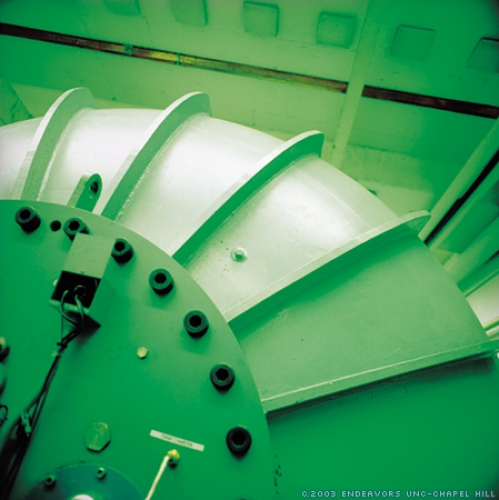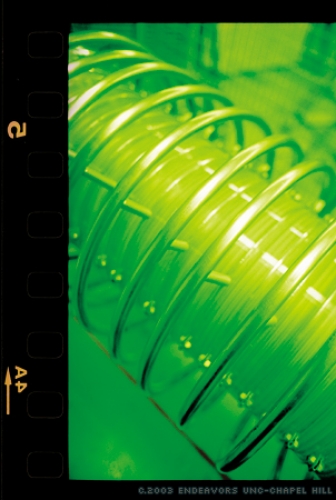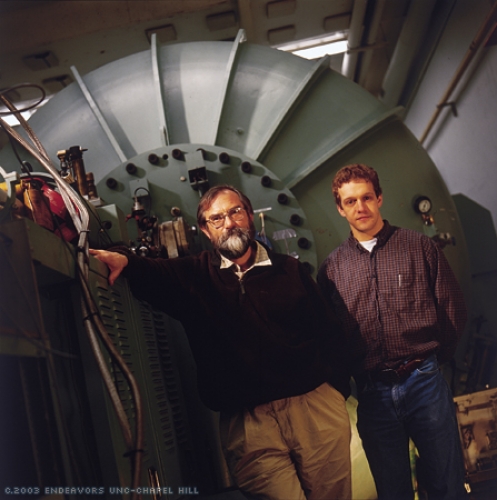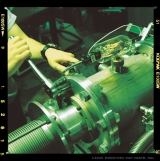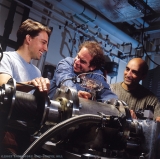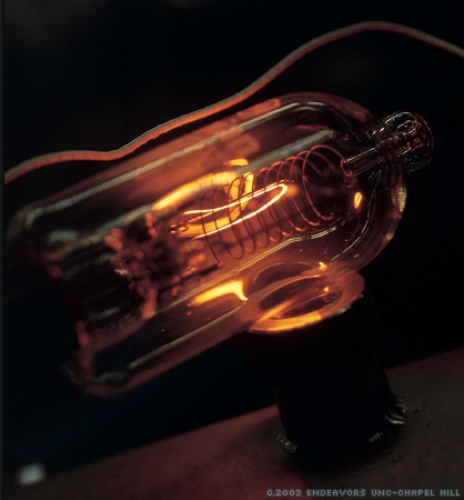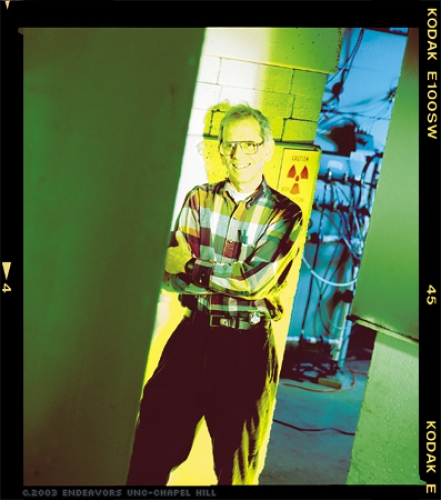Tom Clegg keys in the security code that sends the elevator down to the big vault. The doors open, he clips on a radiation detector, then he starts the tour in the NASA-like control room where a technician named Paul chews on an unlit cigar. Darting through doors, ducking to avoid pipes, Clegg leads the way through a maze of metal cages, concrete walls, and endless wires. Suddenly, he stops. He points out a towering sea-foam-green machine. This green thing — it’s called a tandem Van de Graaff accelerator — makes the work happen. Here, work means hurling atomic nuclei at each other to cause a reaction.
This is the Triangle Universities Nuclear Laboratory (TUNL), one of the largest university-based nuclear physics labs in the nation. Most of it sits underneath a parking lot on the campus of Duke University. There, we said it — Duke. Three universities — Duke, Carolina, and N.C. State — created TUNL in 1965 and jointly operate it, sharing space, equipment, and resources. Clegg, professor of physics and astronomy at Carolina, has been busting stuff apart here for years.
Someone calls out a warning: they’re turning on the accelerator. “When the accelerator’s on,” Clegg says, “depending on which beam is going, radiation levels can be high and you have to be careful where you walk.” Very basically, here’s how these experiments work. The researchers take a piece of thin, postage-stamp-sized foil and coat it with some element — say, silicon. This element — its nucleus, to be more exact — is called the target. A machine called an ion source produces a beam of ionized hydrogen protons — protons that have lost an electron, thereby gaining an electric charge. Various lenses and steerers direct the ion beam to the accelerator, which ramps the particles up to the desired speed.
“We send beams of particles at the targets,” Clegg says. “Our targets are other nuclei, and we bang them together really hard, and shrapnel comes out. The shrapnel are pieces of the struck nucleus, and how that stuff comes out tells us something about the forces that hold it together.”
Clegg is simplifying, of course. Dozens of machines — flux meters, control boxes, dehumidifiers, compressors and filters and valves — work together. Climbing atop a silver vacuum pump, Clegg points out one of the red, plate-sized magnets that help draw the beam where the scientists want it to go. And as Clegg leads the way through the cages and pumps and wires, a continuous roaring, a little quieter than a bus, comes from the many vacuum pumps that keep air out of the beam line. If the ionized particles hit normal air, they’d lose their charge and slow to a stop.
TUNL (pronounced like tunnel) has long been known for this tandem-accelerator setup, which uses an elaborate array of ion sources and beam lines to produce various types of particles and send them around the vault to one of many target stations. For instance, in the late 1980s Clegg led a team of twenty students and faculty in building an ion source that lets them control the spin orientation of the beam particles. Protons, it seems, can spin either clockwise or counterclockwise. “Each one is an extremely tiny magnet,” Clegg says. Knowing their spin orientation from the beginning of the experiment allows control of the magnets’ orientation. These ions with a known spin are said to be polarized. Clegg’s ion machine is known as the “most intense source of dc (continuous stream) polarized positive hydrogen and deuterium ions in the world.” Other ion sources at TUNL produce beams of unpolarized protons, deuterons, and neutrons.
Training students to crawl
Students helped build much of this equipment. “This laboratory has a reputation for training students to crawl around the apparatus,” Clegg says. When something breaks, a graduate student will probably fix it. “They know how to solve problems as they arise,” says Hugon Karwowski, professor of physics and astronomy. Usually about thirty grad students are working at TUNL at any one time. The lab has produced thirty to forty Carolina Ph.D.s, says Ed Ludwig, professor of physics and astronomy and the first Carolina scientist to work there. Most students here work through entire experiments, from building equipment to analyzing results.
Clegg’s, Karwowski’s, and Ludwig’s work has focused on spin dependence in few-body physics, which means studying the magnetic forces that hold two or three protons together. Protons are charged positively, and, Clegg explains, positive charges usually repel one another. But inside a nucleus, they stick together. “So there’s an attractive force inside the nucleus which is stronger than the repulsive force of the charge,” Clegg says. “What holds nuclei together? What is the nature of that force?”
Since its early days, when most of the research focused on the big accelerator, TUNL has continued to grow. When the whole group meets, there is standing room only in the building’s single conference room. One of TUNL’s newest additions — created and constructed by Carolina scientists — is the Laboratory for Experimental Nuclear Astrophysics (LENA) — one of only three dedicated nuclear astrophysics (the nuclear physics of stars) labs in the nation.
Star simulation
So Clegg finishes the whirlwind tour, hands you off to the LENA guys, and disappears into the innards of the vault. Art Champagne walks you to a separate building where he, Christian Iliadis, and a group of students simulate the reactions that power a star. LENA is another metal maze; walk in and you might find Johannes Pollanen, who just finished his senior year at Carolina, trying to find on which table beside which roll of tape and box of lugs he laid his screwdriver. LENA is on a smaller scale than the big vault, though, and the two accelerators (one of which is painted purple) operate at high intensity (number of protons hitting a target per second) but comparatively low energy — one accelerates the beam over a difference of one million volts, the other over a difference of 200,000. The insides of stars work at accelerating energies much lower than that — 5,000 to 20,000 volts. But those reactions can take ten billion years, so to study them the researchers create simulated reactions at higher speeds, then use math to extrapolate the results to actual stars.
While LENA’s equipment is low energy but high intensity, the people here are high energy and high intensity. Explaining why they spend many of their days in this windowless basement lab, Champagne, professor of physics and astronomy, says that our earth is a mere side effect of a reaction inside some star billions of years ago. “We’re living on the debris,” he says. “The oxygen you’re breathing right now was made inside exploding stars.” Such reactions happen constantly, and scientists don’t understand much of what drives them. “The universe is a zoo,” says Iliadis, associate professor of physics and astronomy. Understanding these reactions better, they say, would mean getting a clearer picture of where our universe came from and where it may be going.
Dark energy
Lately, scientists find that the answers to those big questions have a lot to do with stuff we can’t even see. Dark energy — a force that we know nothing about — appears to dominate the universe, according to studies published in the journal Science earlier this year. Scientists have suspected the existence of dark energy because of how radiation and other energy fluctuate at different places in the cosmos. The newest findings support the idea that most of the universe — 73 percent — is dark energy.
“Dark energy seems to act against gravity — it pushes things apart rather than pulling things together,” Champagne says. Because of this anti-gravity effect, some scientists think that the universe is expanding at an ever-increasing rate; galaxies that are far, far away will only move farther, and they will do it faster. And, what we traditionally think of as matter — stuff that is made out of atoms — occupies only about 4 percent of the universe. “Essentially, we don’t know what our universe is,” Iliadis says.
Champagne, Iliadis, and Ph.D. student Bob Runkle may add a clue later this year when they publish work in which they measure the rate of one tiny reaction — and end up revising the age of our galaxy by about 600 million years. The experiments, which Runkle has been conducting for his doctoral dissertation, are complicated, but like other projects at TUNL they involve using an accelerator to hurl beams of protons at a target. In this case the target is nitrogen 14; they shoot protons at it, over and over, for about 1,200 hours. “Since it’s my experiment, I get to work the midnight to eight a.m. shift,” Runkle says. “Which is why we have this couch over here.”
The researchers want to find out how often the proton fuses with nitrogen 14. To determine that probability, they use machines that detect gamma rays, which are high-energy radiation created by the reaction. To home in on true by-products of the reaction and filter out “background” (the natural radiation given off by ordinary objects such as concrete), LENA is equipped with seventeen detectors. “As many as we can afford,” Iliadis says.
What does this experiment inside a machine have to do with the age of the galaxy? Collisions of nuclei — reactions similar to those that go on inside LENA’s machines — provide the fuel for stars. “Tiny particles like the ones in our accelerator control these stars that are thirty times as big as our sun,” Runkle says. “Isn’t that ridiculous?”
As Runkle explains, some stars are compact cars (they burn their fuel slowly), while others are SUVs (they burn it faster). The slower the fuel burns, the longer the star lives. The rate at which some stars burn their fuel is determined largely by the nitrogen 14 reaction, which the LENA team measured more directly than had been done before. They found that the reaction is less probable than previous measurements had indicated, which also means that the reaction happens slower than scientists had thought. Using these data, the team can calculate how fast the same reaction happens inside groups of stars called globular clusters. That reaction rate tells us how fast the globular clusters are burning their fuel.
Revising the age of the galaxy
The LENA calculations show that those clusters are burning fuel slower than expected, which means that the clusters are older than scientists had believed. “How long would that star have to have evolved to reach this point?” Champagne says. “We look at the star right now, and we look at its characteristics, and we can work our way back.” The galaxy can’t be younger than a group of stars in it, so revising the age of clusters revises the age of the galaxy.
The LENA team hopes that once they publish this work, scientists will use the new rate for this reaction to more accurately age-date globular clusters. This new thinking about the galaxy’s age could change how we think about dark energy, because dark energy affects how the galaxy (and the universe) evolves.
“This result is one part of a big picture,” Champagne says. “But it’s something that’s getting more and more clear. I think over the next ten years, there are actually going to be some hard answers about past, present, and future.”
This research is funded by the U.S. Department of Energy. Look for a future story in Endeavors about Carolina’s growing commitment to astronomy and astrophysics, which includes the completion of the SOAR telescope in Chile and construction of the SALT telescope in South Africa. Art Champagne is associate director of TUNL, along with N.C. State University professor Gary Mitchell.

